Mounting and vibration measurement
The introduction to this article has been rewritten several times. The original versions resorted to describing the adverse events that caused the long-announced fan testing to be so dramatically delayed. But the text was always dreadfully boring… the important thing is that everything managed to make it to the start. But before the starting gun, come take a thorough walk around the track where the measurements will take place.
Mounting and vibration measurement
Naturally, each tested fan must first be properly mounted. With all that we want to measure, and with the kind of precision that is required for relevant measurements, even the smallest details matter. The whole mounting system is quite complex and we are happy to have fine-tuned it to maximum satisfaction. Even if it meant hundreds of hours of tinkering. What’s so complicated about it? There’s more.
The fans are installed to the multi-purpose bracket. The substrate is a 2 mm thick metal plate to which the fan is attached, or the fan is attached together with an obstacle (e.g. a filter, hexagonal grille or liquid cooler radiator).
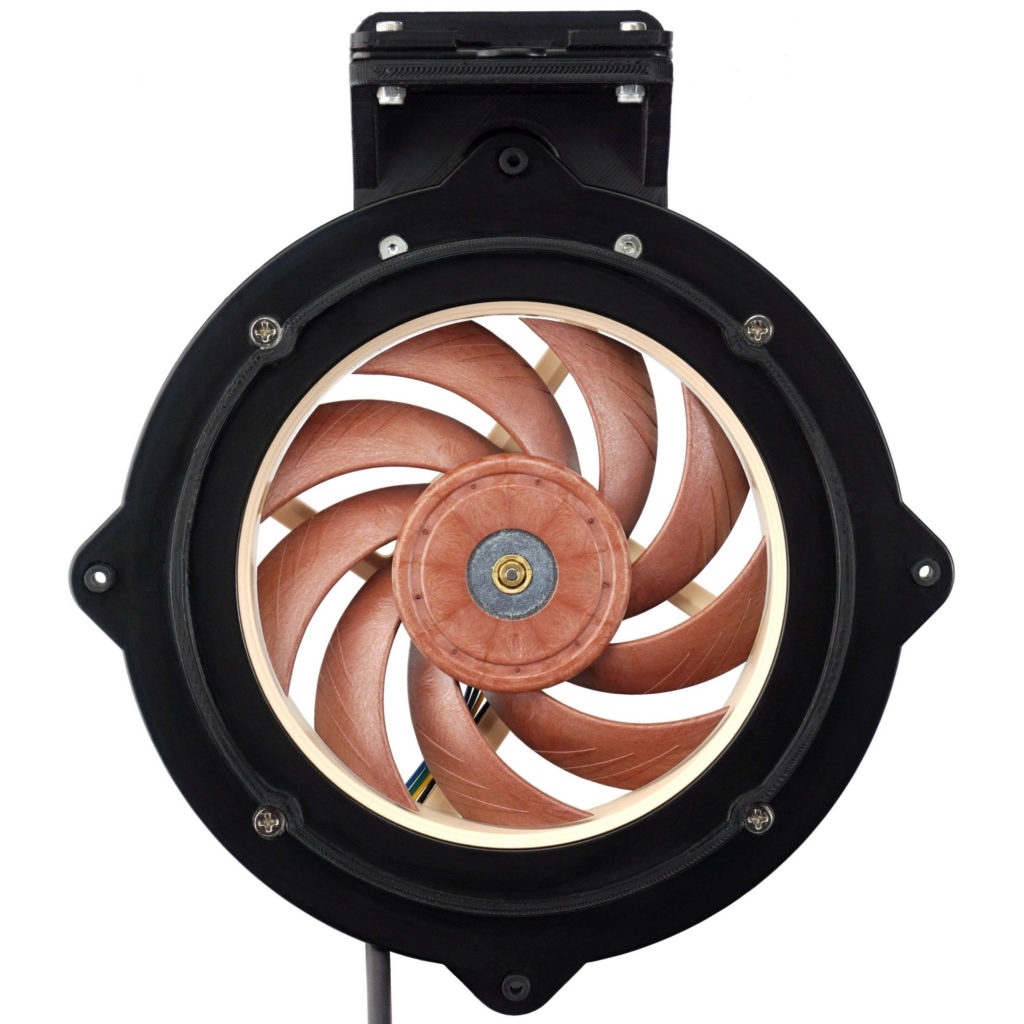
For correct and always equal pressure, the fans are always tightened with the same force with a torque screwdriver. If this were not the case, joints and clearances in the assembly could arise, in short, uneven conditions with undesirable distortion. For example, also for vibration measurement. On top of the fan mount there is also a bracket for the three-axis vibrometer sensor. The latter is magnetically attached via a steel insert, on which the sensor exerts a force of one kilogram and, thanks to the stop, is also always in the same place and in the same contact with the rest of the structure. These are the basics in terms of repeatability of measurements.
In order to capture the intensity at the highest possible resolution, the tray of the holder cannot be too heavy and at the same time it must be strong enough not to twist. This would again cause various distortions. Therefore, we used a hard (H19) aluminium (AL99.5) plate for the construction of the holder, whose weight is just enough so that free movement is not significantly restricted.
To achieve the finest possible resolution for vibration measurement, soft rubber inserts are provided in the mounting holes through which the bracket is installed to the tunnel. And just behind these inserts are silent blocks with a very low hardness of 30 Shore. These are also used so that the vibrations of the fans don’t spread to the tunnel skeleton. If this were to happen, then for fans with more intense vibrations, this secondary noise component, which is not related to the aerodynamic sound of the fan, would also be reflected in the noise measurement results.
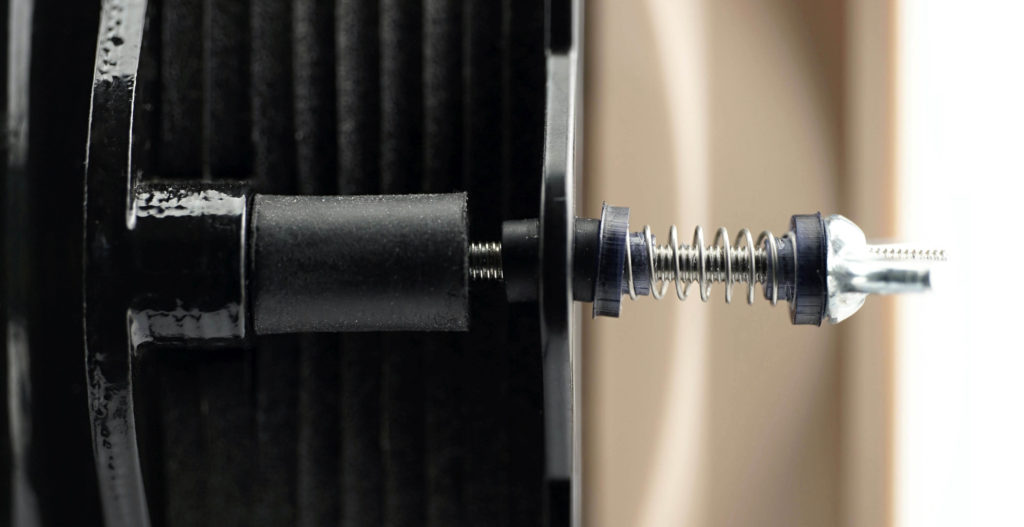
This is where it is good to have ideal conditions, even though they are unattainable in practice, because fan vibrations will always be transmitted to the case skeleton to some degree. But each cabinet will react differently to them, or rather the final noise level will depend on a number of factors, starting with the materials used. Therefore, it is a good idea to filter out this extra noise component in tests and in practice take into account the measured vibration intensities. The higher these vibrations are, the higher the noise addition has to be taken into account.
The silent blocks are naturally formatted to offset the bracket a bit from the rest of the tunnel, otherwise they wouldn’t make sense. This creates a gap that is sealed across the entire surface with a soft foam seal with closed cell structure (i.e., it’s airtight).
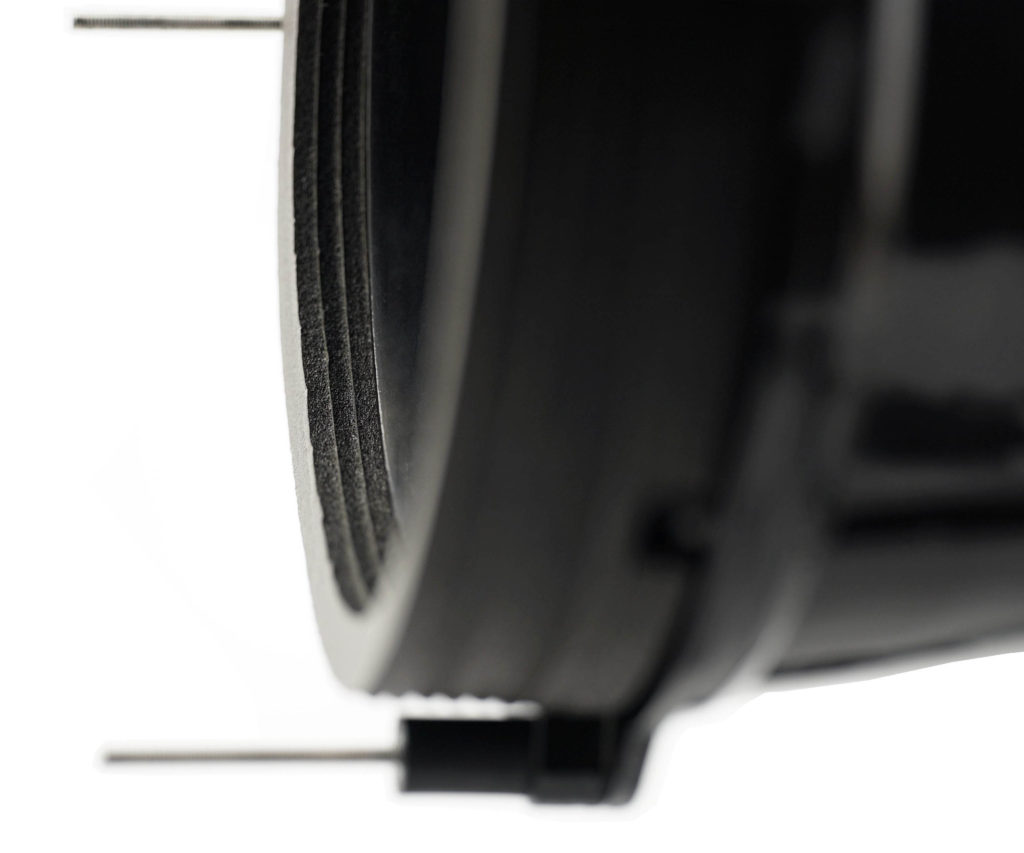
To properly center the fan rotor in relation to the other elements, the bracket includes a protruding frame that follows the inner contour of the seal. And to make matters even more complicated, the frame with the tested fan is pressed against this seal by a small force of compression springs, which in turn is set with the highest possible resolution for vibration measurement in mind and at the same time so that sufficient pressure is generated to maintain a flawless seal.
Vibration is measured with a Landtek VM-6380 vibration meter. It records the vibration speed (in mm) per second in all axes (X, Y, Z). For quick orientation, we calculate a 3D vector from the measured values and graph the “total” vibration intensity. But you can also find your results if you are only interested in a specific axis.
The most complicated part of the tunnel is behind us, and we’ll move on in the next chapter. But we will still stay at the beginning of the tunnel, we will just turn to the peripheries on the sides.
- Contents
- Introduction to fan testing
- Basis of methodology, the wind tunnel
- Mounting and vibration measurement
- Initial warm-up and speed recording
- Base 7 equal noise levels...
- ... and sound color (frequency characteristic)
- Static pressure measurement…
- ... and airflow
- Everything changes with obstacles
- How we measure power draw and motor power
- Measuring the intensity (and power draw) of lighting
- Eight “basics” to start off…





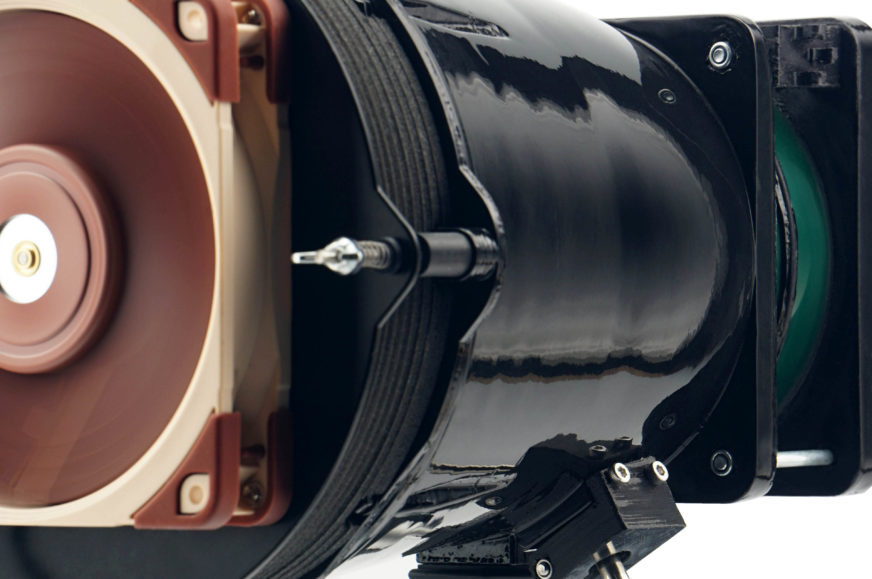
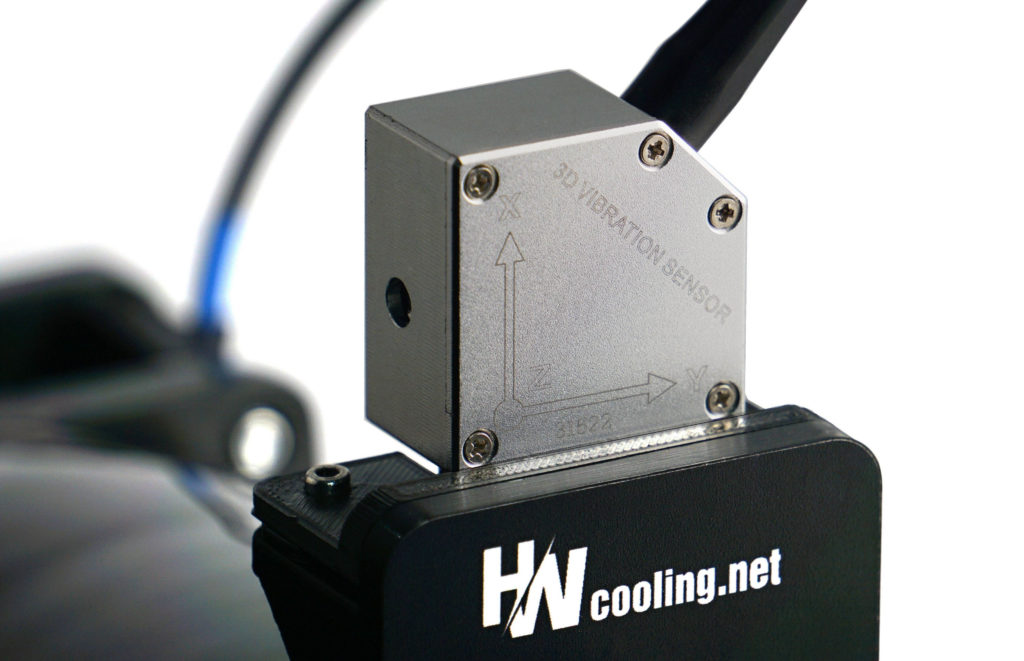
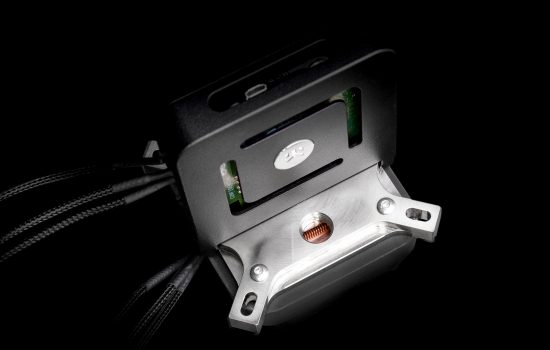
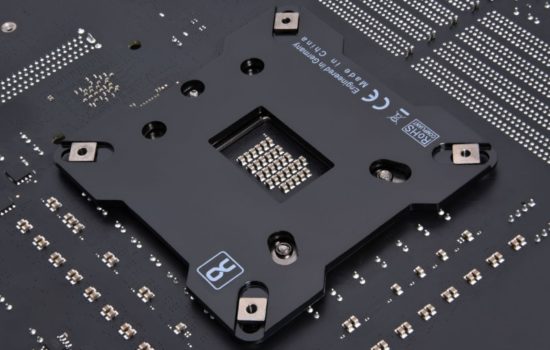
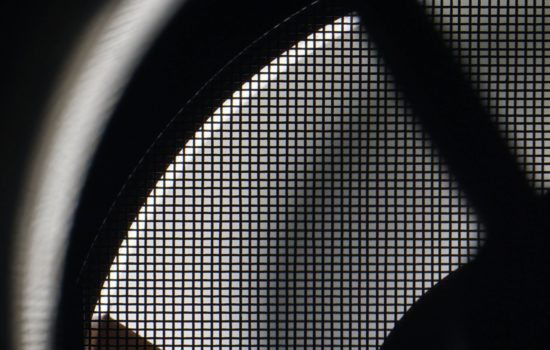



Have you tried PWM controllers other than the Noctua NA-FC1? Does the NA-FC1 offer some advantages over other (often much cheaper) controllers?
We tried our own solution, our own PWM controller. But it was rather clumsy and the only disadvantage of NA-FC1 is that it is not possible to read a numeric value from it. And maybe the fact that it has a narrower rotation range. As long as it is powered by a laboratory power supply, it does not reduce the sensitivity of the exact setting (and what needs to be set can always be fine-tuned in units of mV on the power supply). I have no experience with other off-the-shelf PWM controllers, nor did I know there were any. All PC speed controllers I have used in the past only supported DC control. I have probably the most experience with Scythe Kaze Master Pro and Lamptron Touch. 🙂
Hi,
Could you please clarify the flow in the pull position?
I’m referring to measuring the airflow in a pull fan configuration.
Yes, thanks for asking. Schematically this is the model:
The airflow guide is on the opposite side of the tested fan. This design is the result of several years of research in which we compared different tunnel concepts and in the end we evaluated this design as the most accurate and the most objective. Different tunnels have different problems, for which some fans are relatively advantageous, but others are disadvantageous. This topic is not suitable for a comment below an article, a whole book could be written about it. And we will write it as well, but everything in its time. Some of the wording and details in the methodology are deliberately such that someone cannot adopt it 1:1. We wanted to avoid such a risk, because it would put us at a considerable disadvantage if many things were considered a “good idea” even by someone with significantly better marketing than we have.
But we are slowly approaching the stage when we will be able (our two-year work on tests will not be surpassed :)) to go into details (and also, if I can find the space for it, I would like to revise the overall documentation for the test methodology) and on the basis of the results of our own experiments to analyze in detail why our design is more relevant for the evaluation of fans than the traditional designs with long ducts with a grilled airflow guide. Even a detail such as the orientation of the fan to the tunnel can significantly distort the perspective of the evaluation. When measuring the noise of fans on a tunnel, its walls (tunnel walls), compared to free space, increase the noise of each fan differently. There is a more detailed discussion on this in this thread actually. But these are all things that require reviews of different tunnels with different fans under different conditions to understand sufficiently. We have these data and sooner or later we will certainly process them and publish them in a series of popular-style articles. I can’t promise to do it right away, because it will be a lot of work, which will be commercially inefficient. And serious magazines that want to survive and are based on in-depth reviews don’t have much room for that. But we will certainly get there. It is necessary to start off gently, so that people can understand elementary things/phenomena sufficiently. The design analysis of individual elements in the test tunnels is a more complex topic for the true fan enthusiasts, of which there are only a few, unfortunately. The interest must be always more widespread for the work to make sense financially. With this, we will definitely go financially into the negative, the efficiency in this direction will be low, but we count with it and we have to plan everything properly. Particularly since the series of articles on this subject will be extremely laborious, it is a very demanding topic. Especially if the form of processing is to be understandable even for laymen.
The orientation of the air flow through the tunnel need not interest you at all. With regard to the design of the test tunnel, it is chosen with a view to achieving sufficient laminar flow wherever it is necessary for objective measurements. It has nothing to do with the orientation of the fan on the obstacle. Differences in this respect are shaped primarily by the degree of imperfection of the test system. If someone gets lower airflow on push, it is mainly because the nature of the airflow is more turbulent at the point of dynamic pressure measurement.